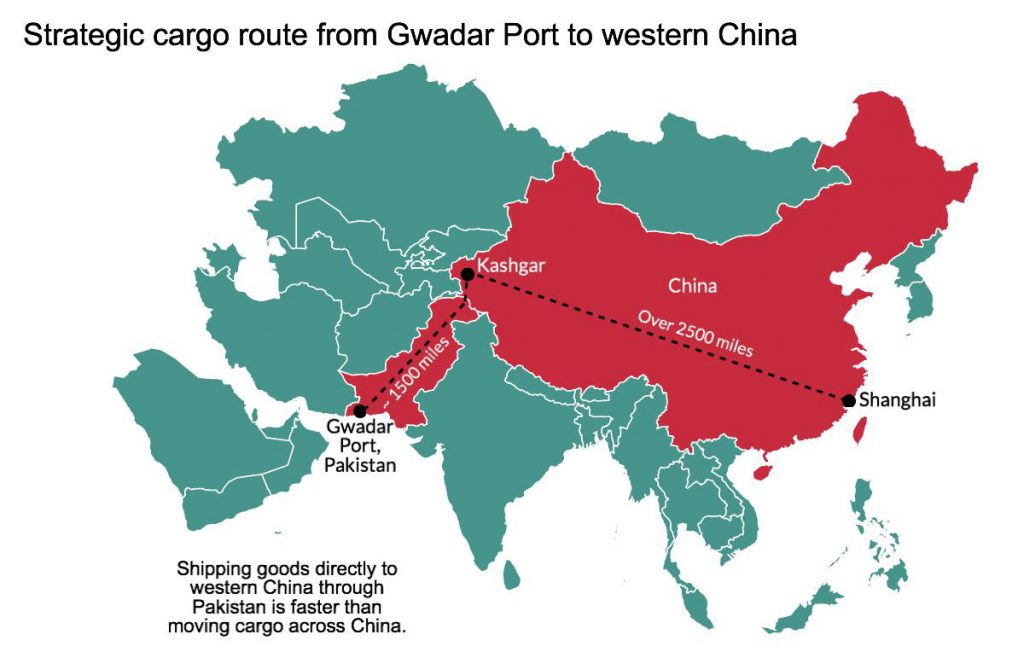Context:
The first shipments on a newly-launched railway line from the Myanmar border to the key commercial hub of Chengdu in western China, that provides China a new road-rail transportation channel to the Indian Ocean, were delivered recently.
Relevance:
GS-II: International Relations (India’s Neighbours, Foreign Policies Affecting India’s interests)
Dimensions of the Article:
- About China-Myanmar New Passage
- About Gwadar Port
- Importance of the IOR for China and its increasing footprint
About China-Myanmar New Passage
- This passage connects the logistics lines of Singapore, Myanmar and China, and is currently the most convenient land and sea channel linking the Indian Ocean with southwest China.
- The railway line currently ends in Lincang on the Chinese side opposite the Myanmar border trade town of Chin Shwe Haw. Plans are underway to develop Chin Shwe Haw as a “border economic cooperation zone” under the Belt and Road Initiative.
- The new trade corridor passage connects the logistics lines of Singapore, Myanmar and China, and is currently the most convenient land and sea channel linking the Indian Ocean with southwest China.
- China also has plans to develop another port in Kyaukphyu in the Rakhine state, including a proposed railway line from Yunnan directly to the port, but the progress there has been stalled by unrest in Myanmar.
- Chinese planners have also looked at the Gwadar port in Pakistan as another key outlet to the Indian Ocean that will bypass the Malacca Straits.
- China’s economic stakes in the Bay of Bengal and this new trade corridor signifies a larger maritime presence and naval engagement in the region which in turn reinforces the string of pearls policy by China.
- Apart from this trade corridor and China Pakistan Economic Corridor (CPEC), China is also planning the China-Nepal Economic Corridor (CNEC) which will link Tibet to Nepal.

About Gwadar Port
- Gwadar is being developed as part of the China Pakistan Economic Corridor (CPEC) to the far western Xinjiang region and it has long been touted as the site for a Chinese base suitable for People’s Liberation Army Navy (PLAN) operations.
- China pursues a “strategic strongpoint” concept whereby strategically sited foreign ports containing terminals and commercial zones operated by Chinese firms can be used by its military.
- Such “strongpoints” offer the potential for China to form a network of supply, logistics and intelligence hubs along the perimeter of the Indian Ocean. This is referred to as the String of Pearls theory.

Importance of the IOR for China and its increasing footprint
- The Indian Ocean is once again at the centre of major geopolitical competition. China’s growing footprint and influence in the Indian Ocean Region (IOR) has made the contest for power and control in the region between China and the US and its partners significant. The Indian Ocean sea lines of communication (SLOCs) are important for many Asian countries because it is both an energy and trade corridor, making these countries sensitive to any vulnerabilities.
- India’s stakes in the IOR are obvious, despite India’s lack of attention to the maritime front. From a security perspective, since independence, India has not faced any significant maritime threat. Much of the Indian maritime security focus was in terms of the relatively minor naval threat from Pakistan and non-traditional threats including piracy and terrorism. While these concerns remain, they have been overtaken by worries about China as an emerging IOR power, with a growing footprint in the region.
-Source: The Hindu





